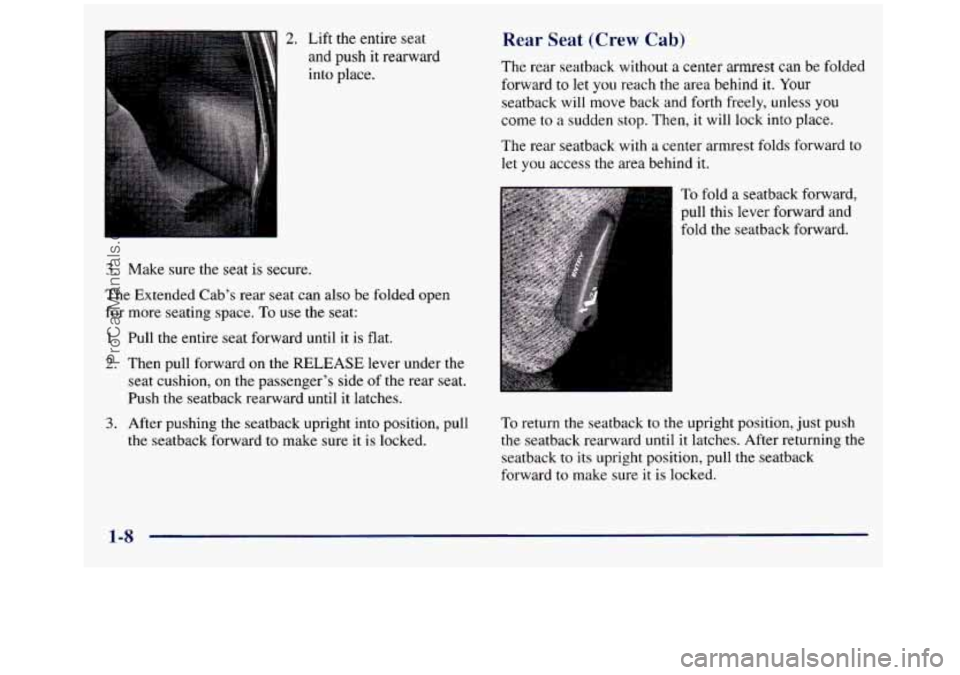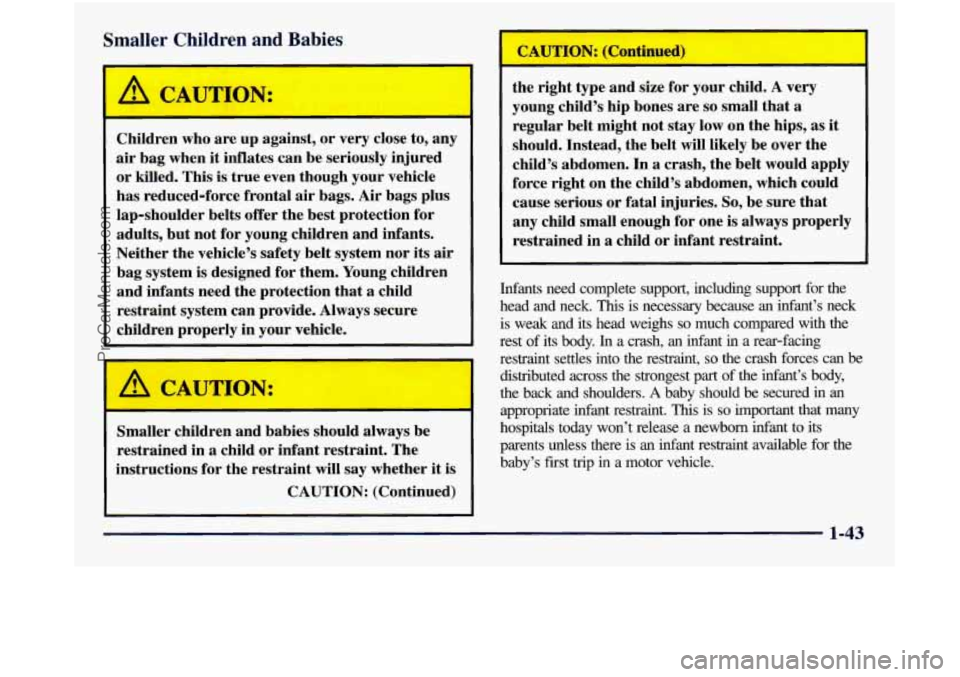Page 20 of 452

2. Lift the entire seat
and push it rearward
into place.
3. Make sure the seat is secure.
The Extended Cab’s rear seat can also be folded open
for more seating space.
To use the seat:
1. Pull the entire seat forward until it is flat.
2. Then pull forward on the RELEASE lever under the
seat cushion,
on the passenger’s side of the rear seat.
Push the seatback rearward until it latches.
3. After pushing the seatback upright into position, pull
the seatback forward to make sure it is locked.
Rear Seat (Crew Cab)
The rear seatback without a center armrest can be folded
forward to let you reach the area behind it. Your
seatback will move back and forth freely, unless you
come to a sudden stop. Then, it will lock into place.
The rear seatback with
a center armrest folds forward to
let
you access the area behind it.
To fold a seatback forward,
pull this lever forward and
fold the seatback forward.
To return the seatback to the upright position, just push
the seatback rearward until it latches. After returning the
seatback to its upright position, pull the seatback
forward to make sure it is locked.
1-8
ProCarManuals.com
Page 27 of 452
3. Pick up the latch plate and pull the belt across you.
4. Push the latch plate into the buckle until it clicks.
Don‘t
let
it get twisted.
Pull
up on the latch plate to make sure it is secure.
If the belt isn’t long enough, see “Safety Belt
Extender”
at the end of this section.
Make sure the release button on the buckle is positioned
so you would be able to unbuckle the safety belt quickly
if you ever had to.
The lap part of the belt should be worn low and snug on
the hips, .just touching the thighs.
In a crash, this applies
force
to the strong pelvic bones. And you’d be less likely
to slide under the lap belt.
If you slid under it, the belt
would apply force at your abdomen. This could cause
serious or even fatal injuries. The shoulder belt should go
over the shoulder and across the chest. These parts
of the
body are best able
to take belt restraining forces.
The safety belt locks
if there’s a sudden stop or a crash.
1-15
ProCarManuals.com
Page 37 of 452
1
l Children who are up against, or very close to, an
air bag when it inflates can be seriously injured
or killed. This
is true even though your vehicle
has reduced-force frontal air bags. Air bags plus lap-shoulder belts offer the best protection for
1 adults, but not for young children and infants.
Neither the vehicle’s safety belt system nor its air
bag system is designed for them. Young children
and infants need the protection that
a child
restraint system can provide. Always secure
children properly in your vehicle.
To read how,
see the part of this manual called “Children” and
see the caution labels on the sunvisors and the
right front passenger’s safety belt.
~
AIR
BAG
There is an air bag
readiness light
on the
instrument panel,
which
shows AIR BAG.
The system checks the air bag electrical system for
malfunctions. The light tells you if there is an electrical
problem. See “Air Bag Readiness Light”
in the Index
for more information.
1-25
ProCarManuals.com
Page 41 of 452

0 Your vehicle is equipped with a crash sensing and
diagnostic module, whch records information about
the air
bag system. The module records information
about the readiness
of the system, when the sensors are
activated
and driver’s safety belt usage at deployment.
switch
on the instrument. panel that you can use to
turn
off the passenger’s air bag. But use this switch
only when you want to secure a rear-facing child
restraint at the right front passenger’s position. See
“Securing a Child Restraint
in the Right Front Seat
Position”
in the Index for more on this, including
important safety information.
0 Unless you have a Crew Cab, your vehicle has a
A CAUT-ON:
If the right front passenger’s air bag is turned
off, the person sitting there won’t have the extra
protection
of an air bag. In a crash, the air bag
wouldn’t be able to inflate and help protect the
person sitting there. Make sure the
air bag is
turned on unless
you are using a rear-facing child
restraint in the right front seat position.
0 Let only qualified technicians work on your air bag
system. Improper service can mean that your air bag
system won’t work properly. See your dealer
for service.
1-29
ProCarManuals.com
Page 47 of 452
Lap-Shoulder Belt (Extended Cab)
The positions next to the windows have lap-shoulder
belts. Here’s
how to wear one properly.
1. Pick up the latch plate and pull the belt across you.
2. Push the latch plate into the buckle until it clicks.
Don’t
let it get twisted. If
the belt stops before it reaches the buckle, tilt the
latch plate and keep pulling until you can buckle it.
Pull up on the latch plate to make sure it is secure.
If the belt is not long enough, see “Safety Belt
Extender” at the end of this section.
Make sure the release button on the buckle is
positioned
so you would be able to unbuckle the
safety belt quickly
if you ever had to.
1-35
ProCarManuals.com
Page 50 of 452
Rear Seat Outside Passenger Positions (Crew Cab)
If you have an Extended Cab, see “Rear Seat
Outside Passenger Positions (Extended Cab)” earlier
in this section.
Lap-Shoulder Belt (Crew Cab)
The positions next to the windows have lap-shoulder
belts. Here’s how to wear one properly.
1. Pick up the latch plate and pull the belt across you.
Don’t let
it get twisted.
2. Push the latch plate into the buckle until it clicks. pull
up on the latch plate to make sure it is secure. When
the lap belt is pulled out all the way, it will lock.
If it
does, let it go back all the way and
start again.
If the belt is not long enough, see “Safety Belt
Extender” at the end
of this section.
1-38
ProCarManuals.com
Page 55 of 452

Smaller Children and Babies
Children who are up against, or very close to, any
air bag when it inflates can be seriously injured
or killed. This is true even though your vehicle
has reduced-force frontal air bags.
Air bags plus
lap-shoulder belts offer the best protection for
adults, but not for young children and infants.
Neither the vehicle’s safety belt system nor its air
bag system is designed for them. Young children
and infants need the protection that a child
restraint system can provide.
Always secure
children properly in your vehicle. the
right type and size for your child.
A very
young child’s hip bones are
so small that a
regular belt might not stay low on the hips, as
should. Instead, the belt will likely be over the
it
child’s abdomen. In a crash, the belt would apply
force right on the child’s abdomen, which could
cause serious or fatal injuries.
So, be sure that
any child small enough for one is always properly
restrained in
a child or infant restraint.
Infants need complete support, including support for the
head and neck.
This is necessary because an infant’s neck
is weak and its head weighs
so much compared with the
rest of its body.
In a crash, an infant in a rear-facing
restraint settles into
the restraint, so the crash forces can be
distributed across the strongest part
of the infant’s body,
the back and shoulders.
A baby should be secured in an
appropriate infant restraint.
This is so important that many
hospitals today won’t release a newborn infant to its
parents unless there is an infant restraint available for the
baby’s first trip in a motor vehicle. I
Smaller children and babies should always be
restrained in a child or infant restraint. The
instructions for the restraint will say whether it is
CAUTION: (Continued)
1-43
ProCarManuals.com
Page 56 of 452
at only 25 mph (40 km/h), a 12-1b. (5.5 kg) baby
will suddenly become a 240-lb.
(110 kg) force on
your arms. The baby would be almost impossible
to hold.
Secure the baby in an infant restraint.
Never hold a baby in your arms while riding in a
vehicle.
A baby doesn’t weigh much -- until a
crash. During a crash a baby will become
so
heavy you can’t hold it. For example, in a crash
CAUTION: (Continued)
I
1-44
ProCarManuals.com